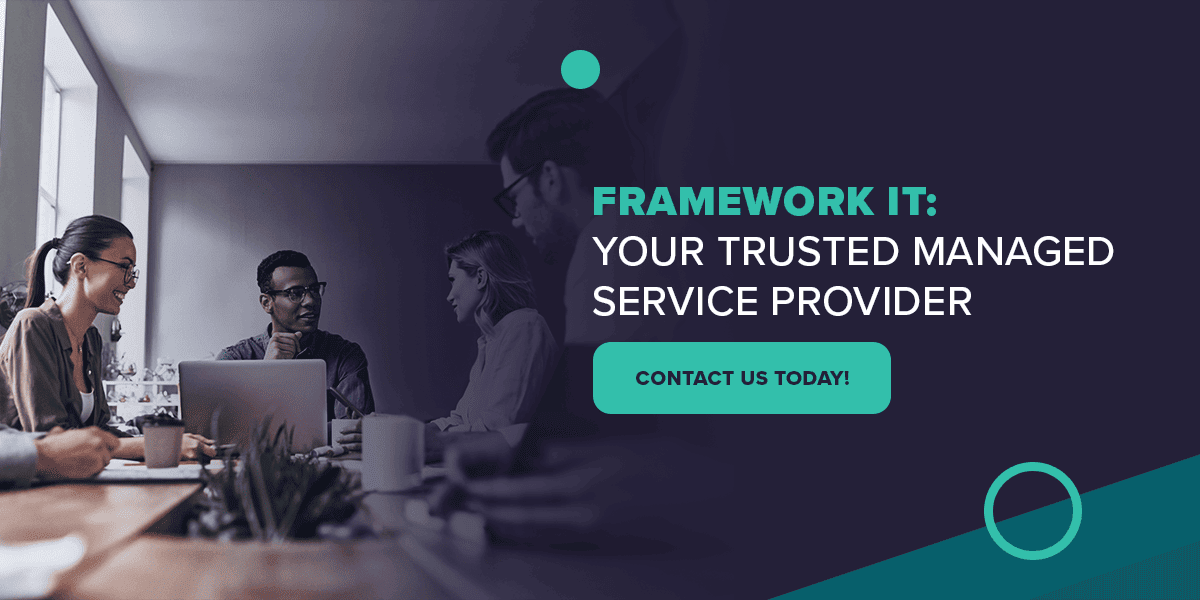The Cost of Efficient IT Support
Is your company in the business of technology? In the 21st century, we’d contend that every business is a technology business. In that vein, we should look at how supporting our entire workforce affects our ability to work and what the true cost of technological support means for our success.
Framework has operated as a Managed Services provider in the Chicagoland area for over a decade. We’ve seen our business change alongside the market and understand what our competitors charge.
This article will explain the typical cost of IT support services and allow you to understand what costs you can expect with IT support. This should help you to make a well-informed decision about IT support and your business. It should help you make a well-informed decision about IT support and your business.
Several components impact the cost of an IT service provider or managed services provider relationship:
- Help desk support
- IT projects, project management, and migrations
- Hardware, software, and other product resales
Help Desk Support Costs
Fixing security issues related to networks, server infrastructure, passwords, and printing will take you away from what you do best. Outsourcing IT support is a common reason that many SMBs hire a Managed Service Provider (MSP) and is a common solution to productivity losses due to technology. In these relationships, IT support partners have a support desk available that you can call, chat or email.
The cost of managed services providers varies as widely as the companies themselves do. A multitude of one-and-two-person shops provide IT support services to several clients. Conversely, many larger, more mature companies focus on outsourced managed services onshore and globally. There’s no hard and fast rule for which size and style of provider will best fit, but you can learn about the basics of an MSP and what questions to ask in some of our other blogs.
Cost structures will come in a few ways: monthly retainers for support, flat rate support, or one-time costs billed hourly.
- Monthly retainers typically start around $1000 per month and will encompass the first 8-10 hours of support per company. $125-250 per hour is typical, depending on the provider’s qualifications, operational maturity, and the complexity of the environment.
- Flat rate support delivered via the managed services model traditionally gets billed per user, machine, server, or a blended approach. In the Chicago market, we see it support rates between $75 and $200 per user per month for companies under 100 users and between $50 and $180 per user for companies above 100.
- One-time costs are referred to as break/fix, where an IT provider is called upon in an emergency or time of need. We don’t recommend this. If you choose to go this route, you can expect to pay between $120 and $300 per hour, and you’ll be subject to the availability of your on-call provider.
IT Projects, Project Management, and Consulting
In addition to supporting your currently deployed technology, your business will want to add new technology, refresh your hardware, or implement new software. There are several specialized vendors with the processes and workplace talent to guide your business through nuanced technology rollouts such as CRM, ERP, and web development.
Though we recommend involving your MSP in any conversation with a technology vendor, the project work a typical MSP handles usually relates to the assets they support, like desktops, servers, and network infrastructure, and your MSP may refer you to an organization with specialization in other specific project areas as needed.
When additional project scope is covered in MSP agreements, it often works out in the provider’s favor, not the clients. Projects tend to arise infrequently. Though a good vCIO or consultant can help you anticipate and budget projects, projects are variable and can pop unexpectedly. If you’re paying for unlimited project services, you’re essentially paying your vendor insurance against any unexpected labor cost.
Instead, you can anticipate paying for projects in addition to your established monthly fee or retainer. Projects are usually billed on a per-hour or flat-rate basis. While each project and objective are very different, it’s challenging to estimate specific costs without additional context; a typical hourly engagement is broken down into tiers.
- Tier 1 (Entry Level Engineer) project: $120-150 per hour
- Tier 2 (Mid-Level Engineer) project: $140-200 per hour
- Tier 3 (Highest Level Engineer) project: $200-300 per hour
Hardware, Software, or Other Product Resale
A good MSP should be your first thought when adopting new business technology. In a healthy vendor partnership, MSPs will deploy or support your purchase. At the very least, you’ll want them informed about its impact on your environment. They should also have established processes for how they make recommendations and should communicate if they have the incentive to do so.
There are a few schools of thought in the MSP community regarding selling products and receiving commissions for things like desktops, VoIP, network infrastructure, and beyond. Some service providers think it is best to remain impartial and to allow clients to search for and select whatever asset at the best cost possible. Others believe it is best to sell everything they can to a client, to manage the customer experience better, and to have full transparency into the supported assets.
At Framework IT, we recognize that IT hardware is highly competitive, and many products are commodities accessible through vendors. If your MSP wants to sell products, check the cost against market rates. If there’s a difference, ask them why. There can be value in paying more to deliver the right product to your environment correctly. A good MSP should be able to deliver the same quality of service on a computer you bought from them as one you bought from Amazon.
How Framework Prices Differently
Being fair and adding value is the best way to build a lasting business. We decided to align our fee structure with our costs and incentivize clients to do the right thing for their business.
Through hundreds of client engagements, we’ve found several indicators define an IT environment’s overall health and structure. Generally, supporting an unhealthy environment costs us more time and money than supporting one outfitted with the best practices. We developed a scorecard that our clients and prospects can take to determine where they fall on that continuum. No business is perfect, and each environment has reasons and rationale for how it was set up. Generally, a business that fits into our IT Best Practices tends to have fewer tech issues than one further down our grading scale.
In every client engagement, we develop a customer roadmap that details the baseline of the IT environment. Our gap analysis helps to provide best practices and a path for that client to achieve them. We then present the anticipated timelines and costs associated with that journey. And finally, we reduce our costs to support that environment based on the customer commitment to best practices.
We reward our clients for doing the right thing because if the IT environment is healthier, so are our agreements. We’ve created this scorecard to let clients see where they fall in our best practice alignment. We encourage you to take our scorecard and find out how much you could save by improving your business. We’d be happy to share that reward with you.
We believe that we should reward our clients for doing the right thing because if the IT environment is healthier, so are our agreements. We’ve created this pricing calculator to let clients see where they fall in our best practice alignment. Find out how much you could save by improving your business. We’d be happy to share that reward with you.
Learn More About How Framework IT’s Unique Managed Services Pricing Model Incentives Clients to Adopt Data-Driven Best Practices, Such as Using Cloud Applications!




